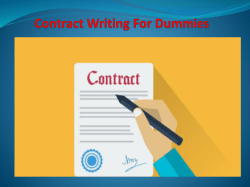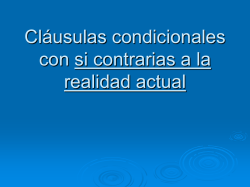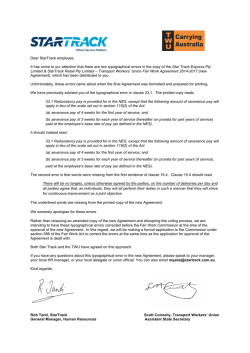
Contract Law - Saying Goodbye Effectively
CONTRACT LAW: SAYING GOODBYE EFFECTIVELY In the first of this two-part series of articles about contract law, we talked about what the elements of a legal contract were and how important signing of a contract was. In this article, we’ll look at what can happen if it all goes wrong and what you can do to protect yourself, and your company when closing a contract and moving on. As someone who has been through the courts over disputed contracts, I can tell you that there is both a financial cost and an emotional one if you don’t carefully orchestrate a contract closure. Many things can happen over the lifetime of a project that may result in the relationship behind the project coming to a close. How you do this can may mean the difference between a long, protracted, and ultimately costly process, or one that goes smoothly and allows both parties to walk away, hopefully relatively unscathed. Reasons to Terminate a Contract You normally need to have a good reason to end a contract. This usually falls under the remit of one of the following: 1. The contract date has ended (there would be a clause in the contract to show an end date). Sometimes these types of contracts are called ‘fixed term contracts’ and are applied to contractors working on specific projects for a company. 2. After giving ‘reasonable notice’. Many contracts will have a clause in them which sets out that one of the parties can give reasonable notice to terminate the contracts. For example, if one party decides that they want to terminate the relationship they must give 3 months, notice to do so, but in those 3 months both parties continue to service the promises of the contract. 3. By breach of contract. This is the most difficult one to enact and often has to be proven in a court of law that the contract breach has occurred. Best to avoid this one if possible. The important thing to note is to make sure your contract reflects the sort of work you are doing with your client. Getting clauses to accurately reflect a job is tricky. For example, in short-term contracts are fine, but come with some caveats. You need to make sure that your contract length truly reflects the amount of time it takes to complete the project. If you underestimate the time and have not completed the work by contract end, the following could happen: 1. You can extend the contract end, but the client may renegotiate less favorable terms 2. There may be a lag between contract renewal, which may impact your scheduling 3. You may be persuaded to work outside a contract while a new one is being prepared – this can result in many unforeseen issues around IP ownership and copyright Contract Clauses and Termination There are a number of clause types that reflect contract termination and or breach: Voluntary Termination: Contract termination under reasonable notice can also be problematic. Contracts, which have a termination clause in, often have a specific set of rules, which enable termination. For example, it may state that termination can occur if one or other party suffers a disability. Termination can also be set as ‘voluntary termination’. A clause of this nature will allow a party to terminate a contract with no agreement from the other side. This type of termination is usually only possible in the USA if there is a material issue with completing the contract, or it simply cannot be performed. Termination for Convenience: This is a double-edged sword kind of clause. It allows either party to simply give notice to terminate the contract for no specific reason. Great, you might think as you may find that your old contract, under old rates, is using up valuable time where you could be working for your much higher rates. If you can get rid of this old client, you can work half as much for twice as many dollars. Trouble is, they can also terminate the contract, at will, whenever they like. So use this clause sparingly and wisely. One other set back with clauses of this nature is that they often have an agreement to pay compensation if enacted – so watch out for that too. Rescinding a contract: Certain sorts of contracts in the USA are allowed to have a rescission clause. They are usually service contracts and allow the buyer / client to rescind the contract within a given period of time, usually 60 days. Impossible contracts: Yes, the word ‘impossibility’’ can be applied to a contract. You’ve got to love lawspeak. This usually applies to contracts, which become impossible to perform. Of course, with this being a legal term, it has ‘degrees of impossibility’ associated with it. Things can be ‘absolutely impossible’ (I’m sure we’ve all experienced those) and ‘subjectively impossible’. Things such as natural disasters, new laws being passed and serious injury, can be used to determine impossibility. If you want to end a contract using this clause, you will need to prove this in court. Breach of contract: This is the biggie and scary one. If one or other party does not perform their promises stated in a contract the contract is said to be breached and can be terminated. Ending the Contract or E Contract Whichever clause you enact to end a contract or e contract, you invariably need to involve a lawyer. This does not mean a day in court. Court costs can be horrendously expensive but advice from a lawyer, although still involving costs, can save a lot of money in the long run. The best way to deal with any contract is to make sure that it is right from the start. Creating a watertight contract does not have to be difficult. Here are a few tips to make sure you get it right first time and avoid your day in court: Be prepared Firstly, you will often find that you can re-use the same basic contract structure for each new client. You may make a few minor changes, but the important clauses, such as termination clauses, often remain the same. Using a lawyer to create a robust contract in the first instance means that future contracts can be based on this template. Digital signature portals, like the ApproveMe system, work with the concept of contract templates for this very reason. Make sure all stakeholders have read the contract Once you have your contract, make sure every signatory of the contract has read it thoroughly and understands the implications of the promises and other clauses. They will be agreeing to them when they add their signature. Again, ApproveMe helps with this process by entering the contract in a document management control system. Have all stakeholders sign the contract If you are using an e contract system, like ApproveMe, you can make sure this part of the process is streamlined. The e contract is sent to each stakeholder, who in turn authenticates that ‘they are who they say they are’, before adding their e signature on the contract. If and when it comes to the time that the contract is to end, or worse, you have a contract breach, you will have documentary evidence in the form of audit trails and even revoked signatures, showing who saw the contract and agreed, on both sides. If you do end up in court, having an ESIGN compliant e signature on an e contract will make the process much easier and therefore much cheaper. Laws like ESIGN and UETA mean that correctly applied digital signatures carry the same weight as traditional pen and ink signatures. Electronic signature, technology, however can go one step further and create fully audited trails of document access, signing, and agreement. It even protects those all-important clauses from abuse. If anyone tries to change that clause saying you need 3 months notice to terminate, the digital signature will become invalid and alert all the stakeholders to the change. To make sure you have your contracts in order, check out ApproveMe’s integrated WordPress digital signing solution. Article Resource: https://www.approveme.com/e-signature/e-contracts-101dealing-with-a-breach-of-contract/
© Copyright 2025










